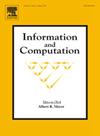利用距离监测分数加权网络链路的线性规划
IF 1
4区 计算机科学
Q3 COMPUTER SCIENCE, THEORY & METHODS
引用次数: 0
摘要
2022年,Foucaud等人在网络监测领域提出了一个新的图论概念——距离-边缘监测数(distance-edge-monitoring number,简称DEM number)。本文研究了距离边缘监测问题的线性规划问题。对于连通图G=(V(G),E(G)),设h为一个函数,该函数赋予每个顶点V∈V(G)一个在[0,1]中的数。对一个顶点子集X∈V(G),记h(X)=Σv∈Xh(V)。然后,函数h称为G的监视函数,如果对于G中的任何边e,监视边e的这些顶点的权值至少为1。G的分数距离-边缘监测数(简称FDEM数),用demf(G)表示,由demf(G)=min (H|)是G的一个监测函数,其中H= H (V(G))。在本文中,我们得到了某些特定图或网络的FDEM数的一些边界或精确值。此外,我们还研究了FDEM数与DEM数相等的图。最后,我们研究了一些凸多面体的FDEM数目。本文章由计算机程序翻译,如有差异,请以英文原文为准。
Linear programming of monitoring the links of a fractional weighted network using distance
In 2022, Foucaud et al. initiated the study of a new graph-theoretic concept called distance-edge-monitoring number (DEM number for short), in the area of network monitoring. In this paper, we study linear programming for the distance-edge-monitoring problem. For a connected graph , let h be a function that assigns to each vertex a number in . For a vertex subset , denote . Then, the function h is called a monitoring function of G, if for any edge e in G, the weights of these vertices which monitoring the edge e are at least 1. The fractional distance-edge-monitoring number (FDEM number for short) of G, denoted by , is given by , where . In this paper, we obtain some bounds or exact values for the FDEM number of some specific graphs or networks. Moreover, we study the graphs where the FDEM number equals to the DEM number. Finally, we investigate the FDEM number of some convex polytopes.
求助全文
通过发布文献求助,成功后即可免费获取论文全文。
去求助
来源期刊

Information and Computation
工程技术-计算机:理论方法
CiteScore
2.30
自引率
0.00%
发文量
119
审稿时长
140 days
期刊介绍:
Information and Computation welcomes original papers in all areas of theoretical computer science and computational applications of information theory. Survey articles of exceptional quality will also be considered. Particularly welcome are papers contributing new results in active theoretical areas such as
-Biological computation and computational biology-
Computational complexity-
Computer theorem-proving-
Concurrency and distributed process theory-
Cryptographic theory-
Data base theory-
Decision problems in logic-
Design and analysis of algorithms-
Discrete optimization and mathematical programming-
Inductive inference and learning theory-
Logic & constraint programming-
Program verification & model checking-
Probabilistic & Quantum computation-
Semantics of programming languages-
Symbolic computation, lambda calculus, and rewriting systems-
Types and typechecking
 求助内容:
求助内容: 应助结果提醒方式:
应助结果提醒方式:


